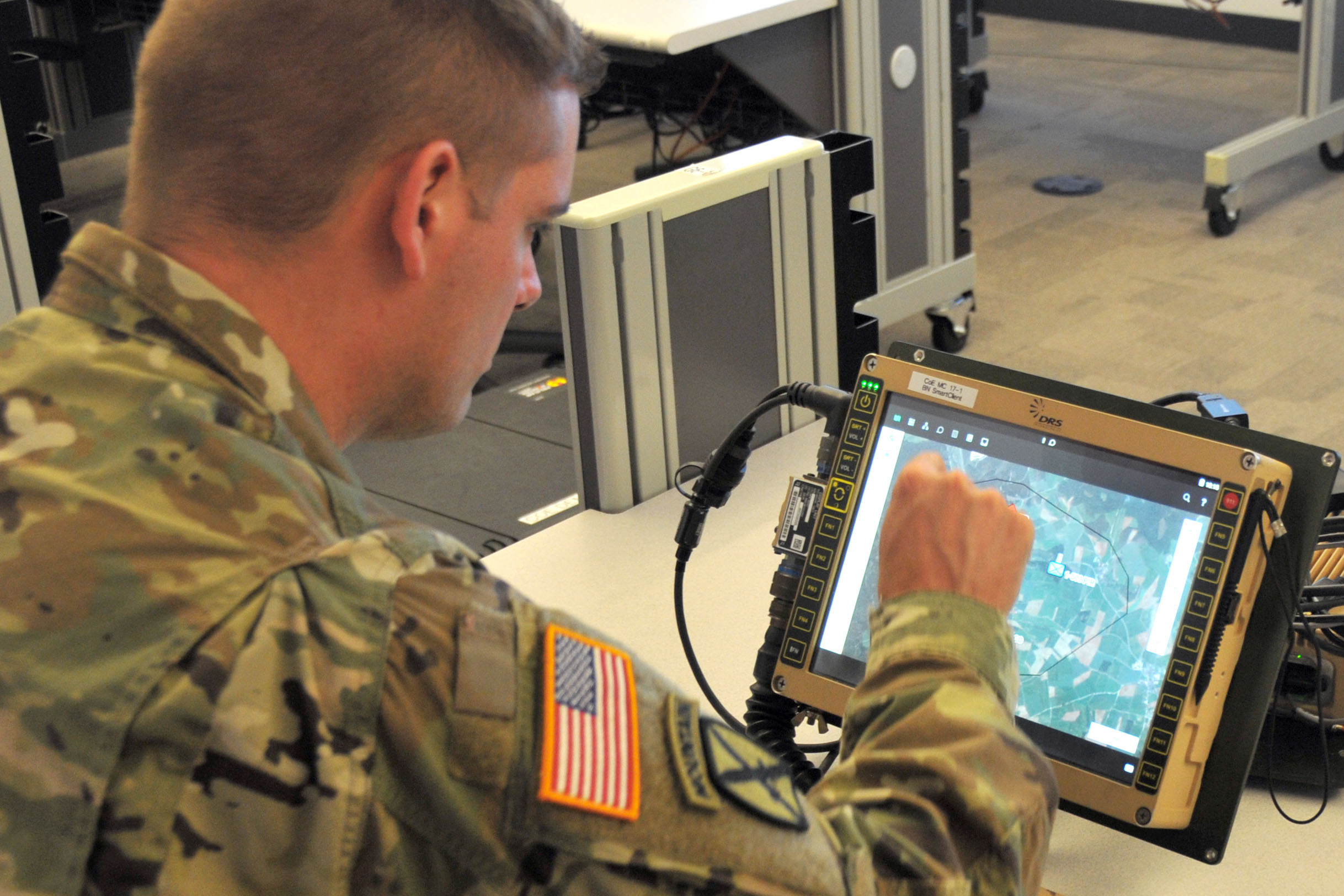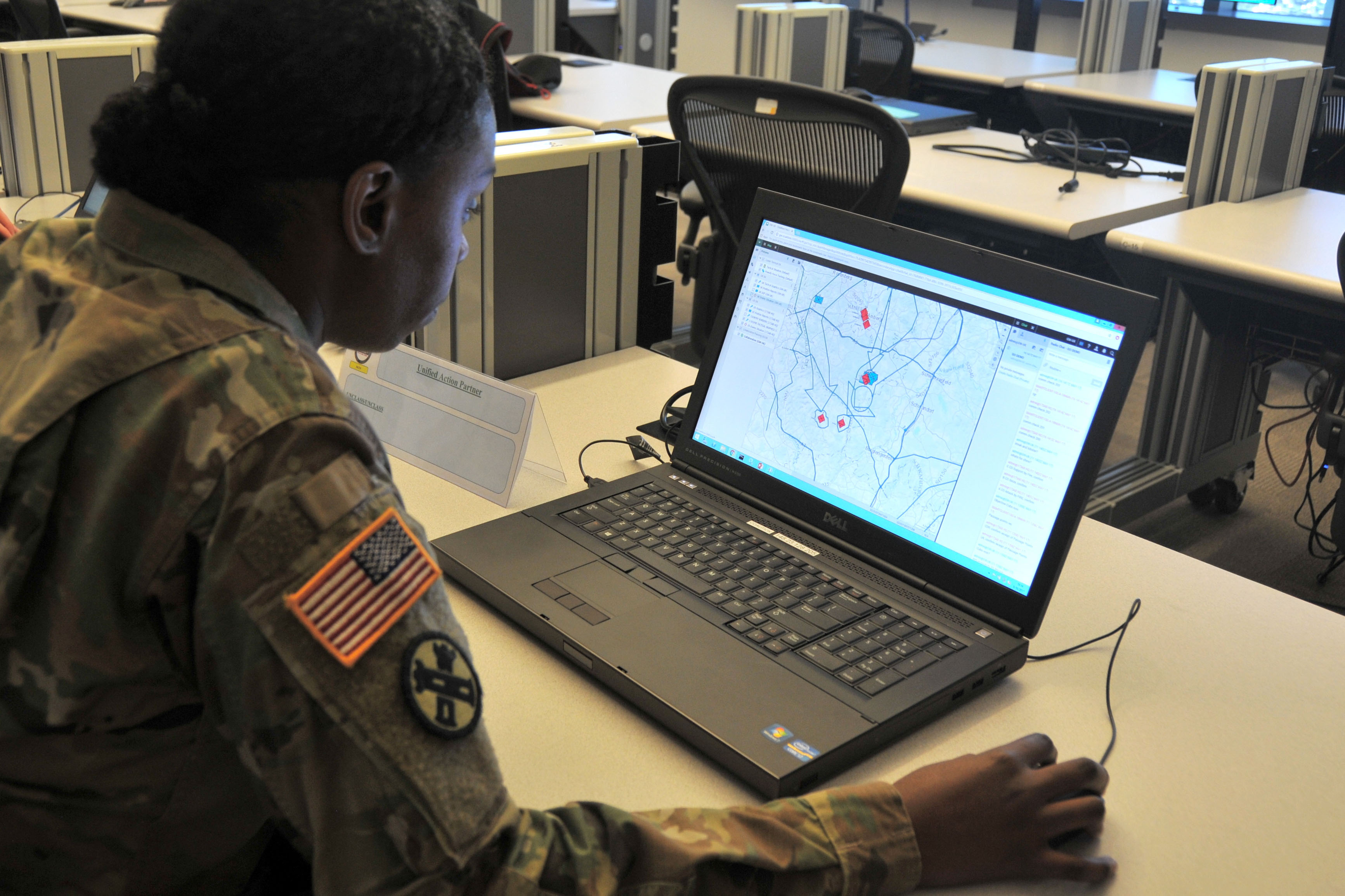
ABERDEEN PROVING GROUND, Md. (Oct. 24, 2017) — A paradigm shift is set to occur inside the Army’s command posts.
Today’s generation of Soldiers use a computing ecosystem — connected and synchronized smartphones, tablets and laptops, unknown to Soldiers a decade ago. These younger Soldiers have embraced the thousands of applications that have transformed communication and collaboration. The Army is now implementing a plan to modernize software applications and hardware used in command post operations to more closely align with what Soldiers have come to expect in their personal lives.
Currently, the computing environment in the command post primarily consists of separately developed systems. CPs are filled with a dozen or more screens displaying battlefield data, along with several types of computers and multiple servers hosting systems that support various warfighting functions such as Movement, Maneuver, Intelligence and Fires. Each stand-alone system provides just a segment of the data that must be fused to generate the commander’s common operating picture.
To reduce the manual collection of COP data, collapse legacy warfighting systems and shrink the technical and physical footprint of the CP, the Army is developing the Command Post Computing Environment. CP CE will feature a simplified user experience by combining warfighting functions into a common user interface, reducing the training burden on Soldiers and accelerating the integration of new capabilities.
As a critical part of the Army’s Common Operating Environment, work on CP CE has progressed significantly over the last year. The Army plans to deliver CP CE initial operational capability in 2019.
“Right now, a commander receives operational information from multiple devices inside the CP because there is not a single application to integrate all applications as a consolidated product,” said Col. Troy Crosby, project manager for Mission Command, which manages the development and execution of CP CE.
“The commander has to mentally fuse information to make decisions. We will now get to one picture that has every overlay of all warfighting information needed to make rapid and informed decisions.”

Capt. John (Mack) Turner demonstrates the Command Post Computing Environment prototype at Aberdeen Proving Ground, Maryland, on May 16, 2017. (Photo Credit: Dan Lafontaine (PEO C3T Public Affairs))
THE CHALLENGE
In the past, each Army Battle Command System was built for a single, specific purpose with multiple developers using different software code and coding languages, resulting in systems that had separate user interfaces, incompatible data models and map engines. Systems were not built for interoperability or communications, subsequently requiring the Army to build and maintain a software ‘middle-ware’ mediation service in order to share data between and among systems.
Each ABCS capability also consists of its own specialized hardware, software, FSR support, and training packages leading to exponential Army cost growth to modernize and maintain capabilities in this stove-piped approach. Individual systems needs to be transported, set up, powered, initialized and maintained — requiring time and effort on the part of soldiers and reducing CP mobility and agility.
THE OPERATIONAL BENEFIT
The CP CE infrastructure, consisting of a new single tactical server infrastructure plus a common software baseline, will provide Soldiers an underlying core CP system upon which additional warfighting functionality can be built. Core CP CE common infrastructure functions will provide chat, a standardized map, message centers and an extensible data model. These core functions will serve as the foundation for every warfighting application and remain the same for every computer and every Soldier, regardless of branch or military occupational specialty.
For example, the same common map that can be used to display friendly and enemy forces can also be used to overlay logistics, intelligence and fires data. Sending a chat message would be done in the same manner regardless of a Soldier’s military occupational specialty as all Soldiers would use the same common chat component.
“We’re moving to a web-based service where the server will be the brain instead of having every laptop locally loaded with hardware and software. Any workstation connected to the server should be able to access the web client environment, log in and be ready to view the common operational picture,” said Maj. Jerry Jones, an assistant product manager for CP CE.
“The applications create a digital overlay, meaning commanders can toggle on and off to see what they need. When I log in, I get warfighting functions specific to my job function.”
CP CE will also interoperate with two additional parts of the COE — Mounted Computing Environment and Mobile/Handheld Computing Environment. To facilitate interoperability, the program office is developing essential movement and maneuver warfighting functionality, allowing users at echelons from corps to battalion to plan and execute operational orders and battle plans across CEs.
This functionality, built on the core infrastructure, will allow an Army divestiture decision for the stand-alone systems: Command Post of the Future, Command Web, and Global Command and Control System-Army legacy systems. Other warfighting functionality will follow in subsequent software releases.
Decreasing size, weight and power — known as SWaP — is a common priority across the Army. The hardware-dense information systems that reside in current command posts robs units of mobility because of the labor-intensive processes to transport, set up, initialize, maintain and dismantle. TSI will provide increased capacity and capability with three versions — small, medium and large — depending on the mission need. CP CE infrastructure software will be integrated and automated with the server hardware to eliminate the need for manually loading the software.
“We’re fielding a different baseline of hardware with TSI. Currently, the Army has nine server stacks dedicated to mission command that weigh 1,200 pounds,” said Lt. Col. Shermoan Daiyaan, product manager for Tactical Mission Command. “In the future, we’ll have one stack that weighs 300 pounds. When the CP needs to move quickly, a 900-pound reduction is huge.”
Training for CP CE will be modeled after the commercial computing world. In addition to some over-the-shoulder training, CP CE will offer built-in user training manual and video tutorials to get users started and set the conditions for how CP CE will operate. Users receive core training on the common functionalities and then more specific training depending on their missions and branches.
“If I teach you how to use the common map and graphical user interface, you know it for all warfighting functions,” Daiyaan said. “We’re reducing operator learning curves by using systems that have similar functions, similar interfaces and are operated in similar ways.”

Maj. Summer Favors demonstrates the Command Post Computing Environment prototype at Aberdeen Proving Ground, Maryland, on May 16, 2017. (Photo Credit: Dan Lafontaine (PEO C3T Public Affairs))
LEVERAGING INDUSTRY TO BUILD THE COMPUTING INFRASTRUCTURE
To meet the Army’s timeline for an initial CP CE deployment in 2019, the Army program office has now employed a commercial-off-the-shelf acquisition strategy, which is expected to result in lower cost and time savings versus building a solution from the ground up. The modified COTS solution will provide the CP CE core infrastructure and a front-end user interface, upon which the Army can build applications to meet the needs of each warfighting function.
“As the infrastructure provider, we’re telling the product managers these are your right and left lanes for application development. We’re communicating the parameters and guidelines, just as a homeowner’s association does,” said Jones. “We’re setting the conditions to help them migrate to CP CE.”
——–
The U.S. Army Program Executive Office Command, Control and Communications-Tactical develops, acquires, fields and supports the Army’s mission command network to ensure force readiness. This critical Army modernization priority delivers tactical communications so commanders and Soldiers can stay connected and informed at all times, even in the most austere and hostile environments. PEO C3T is delivering the network to regions around the globe, enabling high-speed, high-capacity voice, data and video communications to a user base that includes the Army’s joint, coalition and other mission partners.
Subscribe to Army AL&T News, the premier online news source for the Acquisition, Logistics, and Technology (AL&T) Workforce.







